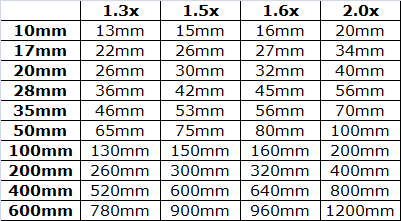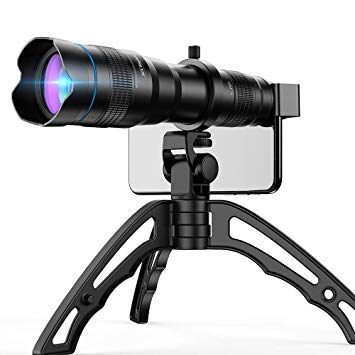The possibility of approaching something artificially through a telephoto lens has always seemed fascinating, almost magical. Being able to transform a point in the distance into the beautiful image of a bird on a branch, or to be able to capture details and close-ups at distances of vertigo, never ceases to amaze me. All this is possible thanks to those lenses so light (note the irony) that we see that carry wildlife photographers or paparazzi and that allow to obtain images of elements that are many meters away without having to approach them.
WHAT IS A SUPER TELEPHOTO LENS?
We consider that a telephoto lens becomes super telephoto, when it has a focal length equal to or greater than 200mm. Although there are telephoto lenses that reach 1,200mm of focal length (such as the Canon brand, which weighs almost 4kg, and is valued at $ 120,000), the most common thing is to talk about super telephoto lenses (also known as long telephoto lenses ) with a focal length between 200mm and 600mm. These telephoto lenses are the most used, which have a greater variety and with more affordable prices , so it will be approximately of these focal ranges that I will talk about today.MAIN CHARACTERISTICS OF TELEPHOTO LENSES
Each focal length is associated with particular characteristics, not only depending on what they are able to approach or move away from what we want to photograph, but other aspects such as the angle they cover, distortion, depth of field or the distance between The different planes of an image.VISION ANGLE
It is the portion of the scene that the target is able to capture but measured in degrees. A wide angle, for example, is capable of capturing a lot of viewing angle (around 60º-100º depending on the exact focal length). Instead, a telephoto lens captures much less portion of the scene (lower viewing angle). As you can see in the following graph, it is reduced as we increase the focal length. In long telephoto lenses we talk about a viewing angle that is between 2º and 10º, which means that we have practically no angle or, which is the same, that we will get closed planes or close-ups at long distances.DEPTH OF FIELD
Super telephoto lenses are also characterized by having a very low depth of field which, translated into the image, means that the background of what we are photographing will always be out of focus. The longer the focal length, the more this effect is accentuated, which we can also accentuate by playing with the aperture of the diaphragm . Remember that the more you open the diaphragm, the more light will enter the sensor and the more depth of field will be reduced (less area focused on the image).DISTANCE BETWEEN PLANES
Another feature of telephoto lenses is how they reduce the distance between planes. That is, the longer the focal length, the more the main figure seems to overlap with the background. Look at the following image and you will see how the planes come together as the focal increases. If we also add the shallow depth of field that these types of objectives have, many times we will simply see a colored background rather than a background with its own entity, as in the following image.DO YOU NEED A SUPER TELEPHOTO LENS?
An objective TV is designed to get very close when we don't usually do it. This is the case of the photograph of:- wild Fauna. ( Here a recommendation of the best lenses to photograph).
- press.
- sun and / or moon .
- sports.
WHAT SHOULD I CONSIDER WHEN CHOOSING ONE?
There are as many goals as you can have. But my main advice is that before looking at anything, you set the maximum budget that you are willing to spend and once you have it, you start looking at the rest of the features. Because this is as always, the more expensive, generally, the better, there is not much secret. And as you can get excited to infinity and talk about expensive goals, it is best to set a maximum budget before starting .- Luminosity: With such long focal points, the luminosity of the objective is very important in order to work with speeds high enough to freeze the image without trepidation or movement.
- Fixed optics or zoom ?:As a lover of fixed optics, I usually defend them to death but in this case, I sincerely believe that a zoom lens can be more useful than a fixed one. Above all and mainly, because what you want to photograph normally, moves, and you can't always do it
- Image stabilizer: If there is a lens that needs a stabilizer , it is certainly one with a long focal length. With the super telephoto lenses, even working at high speeds, you will see that any trepidation or slight movement can be recorded in the image.
SOME BASIC NOTES TO WORK WITH A SUPER TELEPHOTO LENS
You can not embark on the adventure with your newly released toy without first investigating a little about the best way to take advantage of it . Although enthusiasm and practice are 50% of an image, preparation, technique and material are the other half. So here I leave you some basic notes to keep in mind before going for a walk with your brand new super telephoto lens.- You will need a tripod yes or yes ... and a really good one. Very robust and with swivel ball joint. For this type of lens with such long focal lengths, the ideal is to fix them through a ring to the tripod to give them extra stability.
- Self-timer: because any vibration working with such closed fields can lead to a wrong photo.
- Ideally, check if your camera can block the mirror to prevent it from rising to contribute to the trepidation of the image.
- Work with as much light as possible; that is, with generous apertures, to be able to use good shutter speeds.
SUPER RECOMMENDED TELEPHOTO LENSES
Notice for navigators: here you have a small selection of long telephoto lenses to take a look at. The selection is based on a good value for money. There are longer focal lengths and large openings but they are unpayable and are hardly justified unless they are your way of earning your bread. Now, I warn you that in these objectives, quality is expensive1. CANON EF 100-400MM F / 4.5-5.6L IS
Canon EF 100-400mm f / 4.5-5.6L IS II USM - Lens for Canon (Focal Distance 100-400mm, Aperture f / 4.5-5.6L IS II USM), Black and White * - Camera
Price: € 1,997.00
(As of: 2020/01/22 7:29 am - Details)
6 new from € 1,997.00 0 2nd hand
(* = Affiliate Link / Image Source: Amazon Affiliate Program)
2. NIKON AF-S 200-500MM F / 5.6E ED VR
Nikon AF-S NIKKOR 200-500 mm 1: 5,6E ED VR - Objective * - Accessory
Price: (price not available at this time)
(As of: 2020/01/22 7:29 am - Details)
0 new 1 From 2nd hand from € 1,144.00
(* = Affiliate Link / Image Source: Amazon Affiliate Program)
3. SIGMA 150-600MM F / 5-6.3 DG OS HSM | S
For Canon:Sigma 150-600 / 5-6.3 DG OS HSM (C) EOS - Objective * - Electronics
Price: € 950.94
(As of: 2020/01/21 5:52 pm - Details)
9 new from € 950.94 1 Second hand from € 1,068.75
(* = Affiliate Link / Image Source: Amazon Affiliate Program)
Sigma 150-600mm F5-6.3 DG OS HSM, Lens for Nikon F reflex camera (150 - 600 mm, f / 5 - 6.3), black * - Electronics
Price: € 906.99
(As of: 2020/01/21 5:52 pm - Details)
8 new from € 530.00 1 Second hand from € 1,186.34
(* = Affiliate Link / Image Source: Amazon Affiliate Program)
4. TAMRON SP 150-600MM F / 5-6.3 DI VC USD
For Canon:Tamron T80174 - SP 150-600 mm F / 5-6.3 Di VC USD G2 lens for Canon, Black * - Electronics
Price: (price not available at this time)
(As of: 2020/01/21 5:52 pm - Details)
8 new from € 1,099.00 1 Second hand from € 1,021.00
(* = Affiliate Link / Image Source: Amazon Affiliate Program)
Tamron T80177 - SP 150-600 mm F / 5-6.3 Di VC USD G2 lens for Nikon, Black * - Electronics
Price: € 951.05
(As of: 2020/01/21 5:52 pm - Details)
You save: € 647.95 (41%) (41%)
10 new from € 592.00 1 Second hand from € 1,021.00
(* = Affiliate Link / Image Source: Amazon Affiliate Program)



